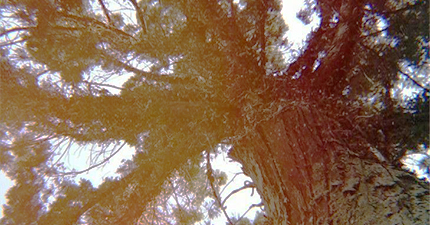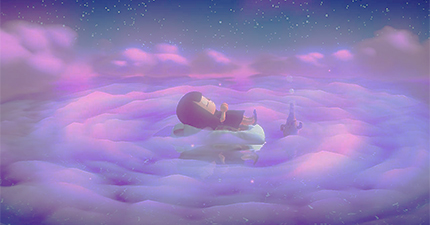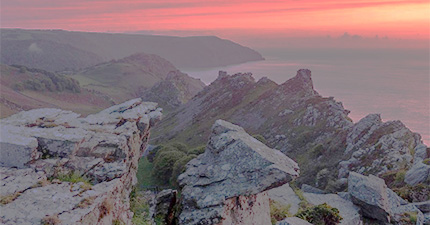This is the third article of this series! In the first article, we focused mostly on yin and yang. In the second article, we looked at how yin and yang become the eight trigrams or bagua.
In part three, I want to really get into the trigrams. Let’s look at different arrangements of the trigrams, mythologies behind these arrangements, and applications of the arrangements.
First of all, the eight trigrams are used to create 64 hexagrams. Every hexagram is just two trigrams stacked on top of one another. The bottom one is the interior trigram and the top one is the exterior trigram. You can check the hexagram for a date to elect events or you can cast yarrows sticks or coins to generate hexagrams as a horary tool.
This type of divination tends to be really direct. It really doesn’t beat around the bush. Recently, I consulted the yi jing on whether my vape will break or not. I got hexagram 18 (poison) changing into hexagram 41 (harmful). I guess whatever ancestor is talking to me doesn't care about whether my vape will stay working or not—they just see the whole situation as poison.
The trigrams on their own can be arranged in two arrangements. There’s the early heaven arrangement and the later heaven arrangement. The two arrangements of the bagua have really different uses. Basically, the early heaven arrangement is not for living people. The later heaven arrangement is for the living.
This is Fuxi’s Earlier Heaven arrangement:
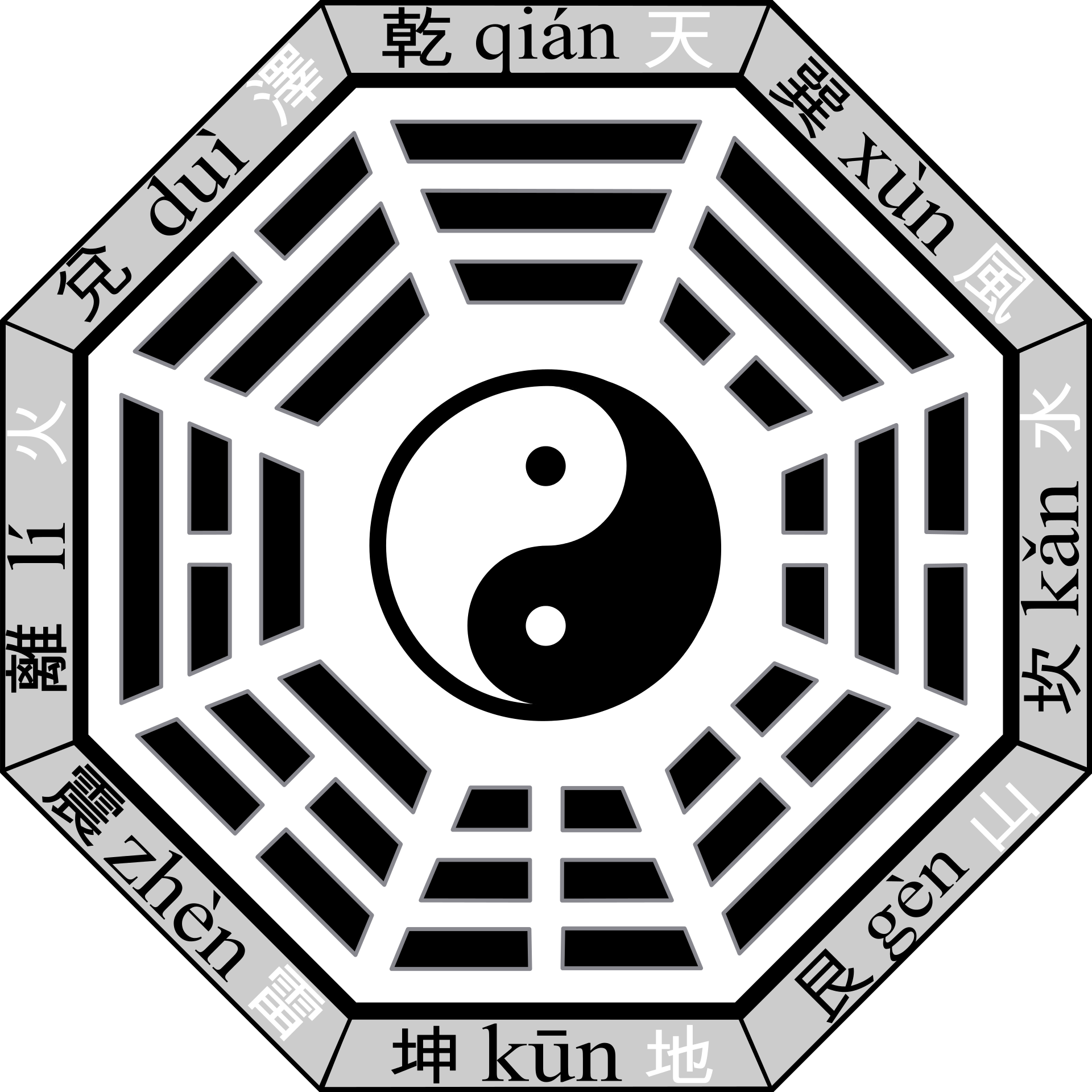
In the early heaven arrangement, ☰ is the highest trigram and on top. ☷ is on the bottom. Fire ☲ and water ☵ are at the sides at east and west. These are the middle children. Then, ☰ as father is flanked by his eldest daughter and youngest daughter. ☷ as mother is flanked by her eldest son and youngest son. The eldest son is opposite the eldest daughter and the youngest son is opposite the youngest daughter.
If you look at the lines of the trigrams in the early heaven arrangement, you can actually see that the composition follows the rising of yin yao and yang yao. Moving from the bottom clockwise, ☷ becomes ☳ which adds one more yang yao. ☶ becomes ☲, gaining one more yang yao. ☲ then becomes ☱ where yang has almost reached its maximum. ☱ then becomes ☰ which is fully yang. From there, yang can only decrease while yin increases. It moves from ☰ into ☴ into ☵ and into ☶. This is the increase of yin. ☶ eventually becomes ☷ and starts the cycle again.
This arrangement is too perfect! It’s supposed to show the ideal position for everyone and everything. Everyone is in their places. It’s all based on the steady increase and decrease of yin and yang. When everything is in place, then nothing can move. That’s why the early heaven arrangement doesn’t describe living things. It can only describe dead things and things yet unborn. If everything is perfect then there is no life.
This is King Wen’s Later Heaven arrangement:
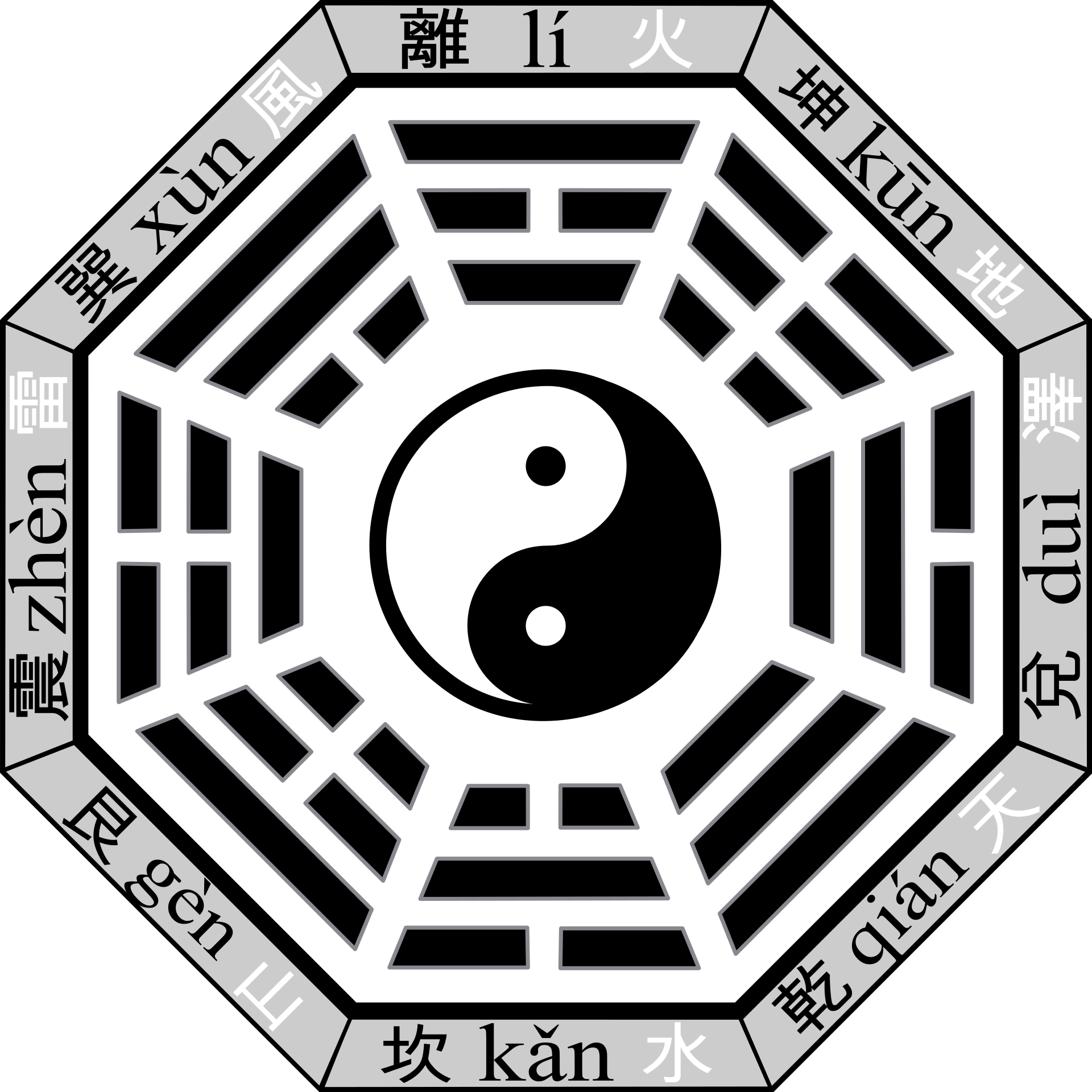
The later heaven arrangement tells us about life and is used to describe seasonal change. Fire ☲ is the one in the south. This equates to noon or summer and shows us that this time is the hottest time. Water ☵ is at the bottom and equates to north. This is winter or midnight. ☲ as fire also corresponds to the 五行 or wuxing fire. ☵ corresponds to the water as a phase within the five phases of the 五行.
Fire and water are both about movement. That’s why the later heaven arrangement, which is about life, positions them as top and bottom. In the early heaven arrangement, fire and water were at the equinox points because they signify change—either rising or sinking.
☳ thunder and ☴ wind are in the east and southeast positions. This is actually the morning or spring. Together, ☳ thunder and ☴ wind are wood. This wood season leads right into ☲ fire or summer. These three trigrams all right next to one another are the yang part of the later heaven arrangement.
☱ marsh and ☰ cosmos are in the west and northwest positions. This is fall leading into winter. Both of these describe a gradual cooling and they become ☵ water. These three trigrams are the yin part of the later heaven arrangement.
Between the yin part of the arrangement (☱, ☰, and ☵) and the yang part of the arrangement (☳, ☴, ☲) we have ☷ earth and ☶ mountain. These are both earth. Earth is the phase that is thought of as neutral and is equally yin and yang. Depending on the context, earth can act as yin or yang. When you move through the seasonal cycle, earth is always found between each phase.
Hetu and Luoshu
Where do these two arrangements of the bagua come from? We’re not actually sure. They’re kind of mythic. But guess what? They actually come from the region of my hometown.
The Central Plains region often floods because of the Yellow River. Even today, you hear about people dying in floods. The flooding is probably getting worse because of climate change. The flood is a problem and causes famines. The arrangements of the trigrams are connected to the river and the river’s floods as a mythic narrative.
The early heaven arrangement actually comes from a horse. Fuxi, who is an emperor but also mythic figure who was supposed to be half snake, was standing by the Yellow River when a huge horse came running out of it. The huge horse is called a 龙马 or dragon horse. It’s a mythic being that represented the flood. In the story, there was a picture on the horse’s side:
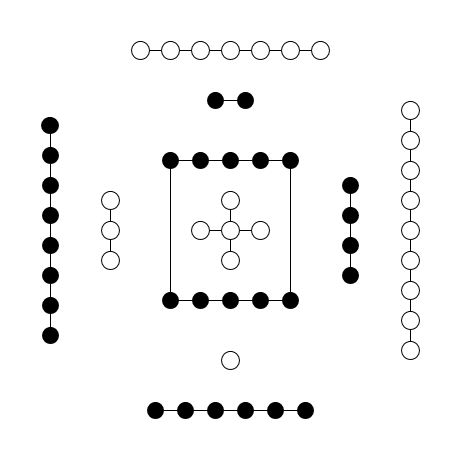
This picture is called the 河图 and shows a bunch of circles. The odd ones are white and are yang. The even ones are black and are yin. Count with your eye from one to ten. What do you find?
You start from the bottom. Then you move up top. That’s north to south. Then you move east and west. Five is in the center. Then you start over but you’re at six instead of one which is even. That’s why there’s six black dots next to the one white dot on the bottom. Seven goes with two, eight goes with three, and nine goes with four. Ten is even and is shown in black wrapped around the five already at the center. There’s a completely even amount of yin and yang in all directions and in the middle.
Eventually, the 河图 became the early heaven arrangement of the trigrams.
There’s a second story about another flood. This time, there wasn’t a king and it wasn’t the Yellow River that flooded. Instead, the Luo River flooded. All the common people living close to the river sacrificed to the river god. The river god sent them a huge turtle (probably a flood since gods are fucked up in that way). This turtle, a mythic being called the 龙龟 or dragon turtle, had a picture on its back and that picture is called the 洛书. It looks like this:

The 洛书 is pretty simple. It's sometimes called the magic square because of its mathematical symmetry. You have the even numbered dots in black, representing yin, in the corners. You have the odd numbered white dots, representing yang, in the sides and in the middle. It only goes up to nine this time since all of the opposite dots add up to ten. One faces nine, two faces eight, three faces seven, and four faces six. The 洛书 eventually becomes the later heaven arrangement of the trigrams.
In Chinese mythology, dragons are in charge of the weather. That’s why the horse and turtle are called dragon horse and dragon turtle. It’s also because they were eight feet tall. Chinese people like to call big things dragon (lobster is dragon shrimp). Horses and turtles are very different animals. Horses live fast and die young while turtles can live for centuries. Horses are associated with the military since generals have to ride horses. Turtles are associated with language since the first words were carved on turtle shells. The horse appeared to the emperor while the turtle was given to the people.
It’s really just two types of power. There’s another concept that we won’t get into called 文 and 武 (wen and wu). 武 is military government and 文 is civil government. They’re also two different types of masculinity and, in popular media, you’ll usually see a nerd type male paired with a jock type male. The horse is the jock and the turtle is the nerd. They’re basically the soldier and the scholar. Together, they make a government.
What is a dragon horse and dragon turtle? First of all, they come from the river. Dragon is also about weather. They’re something to govern around or against. Lastly, and most of the sources I have encountered say this, a dragon horse is eight feet tall. This last part is more than just a small detail. It’s a key part of the whole thing.
They’re floods! Everytime this region floods, it fucking sucks. People die. Floods produce famines and locusts. That leads to more people dying. I remember when I was a kid living near the Yellow and Luo rivers. It would flood all the time and it would be up to my mom’s waist. Every building in this region keeps a lot of sandbags near doors to keep out the flood waters. The eight feet tall thing is most likely a record of how tall the flood waters got one time. Eight feet is pretty high. It’s higher than most people and horses. That's pretty dangerous.
It's funny how many dragons show up in Chinese astrology. Depending on where you live, dragons might be river floods or typhoons or just rain clouds. Dragons are a folk symbol for the weather. Today, we associate dragons with kings but the first emperor to use the dragon as a symbol, Liu Bang, was actually called the peasant king. He was a common person who usurped the old king. He chose to use a dragon to symbolize himself because he wanted to show that he represented the people.
五行 (Five Phases)
Enough mythology and speculation! Let’s get into application.
Here is the 五行 wuxing:

I got this image from Wikipedia (I got all these pictures from Wikipedia). It shows you the generating cycle of the five phases: wood creates fire since wood burns, fire creates earth since it makes ash, earth creates metal when it’s compressed, metal creates water through condensation, and water creates wood since plants drink water.
It also shows the control cycle: wood controls earth since roots clench around soil, earth controls water since it keeps rivers and lakes from overflowing, water control fire since water can put fire out, fire control metal because fire can forge metal, and metal controls wood since knives can cut rope or axes can cut trees down.
The wuxing is actually derived from the river diagrams. That's why I wanted to show you the bagua and the river diagrams before this. Each of the trigrams correspond to a phase. Thunder and wind are both wood. Fire is fire and water is water. Earth and mountain are earth. Marsh and cosmos are metal. I'll show you how the five phases or wuxing turn into ten heavenly stems that mimic the layout of the hetu river diagram in the next article. First, let's just enjoy the wuxing on its own.
The five phases are really just the different phases of life. Earth is the neutral one and is found at the center. It actually represents people. It’s also the stomach and its flavor is sweet or grainy. Earth is associated with Saturn. It’s not associated with one season since it exists between seasons and stores different things.
Fire and wood are both yang. Wood is spring and is mostly horny energy. It’s also curious and has to do with the eyes and liver. The flavor of wood is sour and it’s associated with Jupiter. Fire is summer and has to do with all kinds of passion, both love and hate. That’s why it lives in the heart. It’s expressed with the tongue and its flavor is bitter. It has to do with Mars.
Metal and water and both yin. Metal is the fall. It’s compressed and rigid. It’s flavor is pungent and it’s the large intestines. Its emotion is grief and it’s linked to Venus. Water is intellectual. It’s linked to Mercury. It has to do with the ears and kidneys, which produces urine or water. Its emotion is fear and its flavor is salty.
Honestly, you can do a lot with just this. Again, the wuxing is about life so it tells us about living things. It tells you about different flavors of food and how every organ recuperates and exhausts itself during a year or day. For example, fire season is summer. That means that the heart is tired during the summer because it’s overused. You could say the same about noon. That’s why you should take a nap around noontime, to rest your heart. It’s also why you shouldn’t exercise at noon or during the hot days of summer.
There’s all kinds of things you can read from the wuxing. Morning is good for reading since wood is the morning and also lives in the eyes. You should drink a lot of water in the evenings because your kidneys need to be flushed out at night (water is night). There’s even cooking practices that use all five flavors (sour, bitter, sweet, pungent, and salty) to promote different organs. But! The wuxing is also used in astrology.
